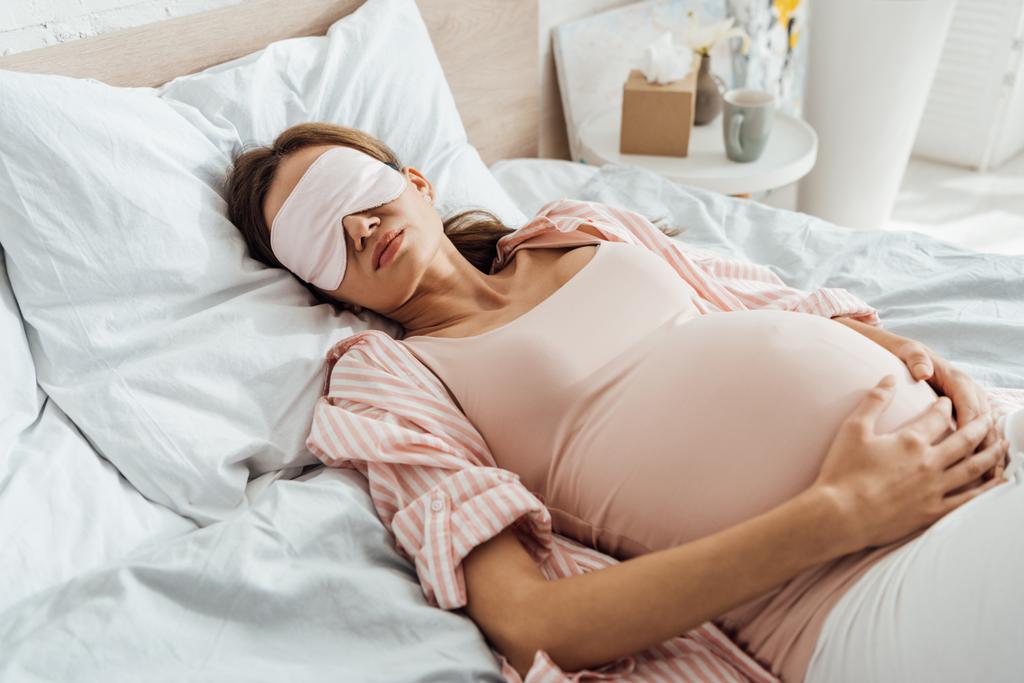Discover the pros and cons of sleeping on your back during late pregnancy.
Should I Avoid Sleeping on My Back During Late Pregnancy?
Many expectant mothers find themselves tossing and turning at night, desperately seeking a comfortable sleep position. There’s a constant stream of advice on what’s best for you and your growing baby, leaving you feeling confused and overwhelmed. One particular question that often arises is whether you should avoid sleeping on your back during late pregnancy. Let’s dive in and explore the fascinating world of sleep positions during pregnancy!

Understanding the Importance of Sleep Positions During Pregnancy
Pregnancy is an amazing journey filled with remarkable changes in your body. As your belly grows and your center of gravity shifts, finding a restful sleep can become increasingly challenging. Sleep positions not only impact your comfort but also play a vital role in your overall maternal and fetal health. So, let’s dive a little deeper into this topic!
During pregnancy, your body goes through numerous physiological changes to accommodate the growing life inside you. These changes can affect various aspects of your health, including your sleep patterns. It’s no secret that getting enough sleep is crucial for your well-being, but did you know that the position you sleep in can have a significant impact on both you and your baby?
The Role of Sleep Positions in Maternal and Fetal Health
Your sleep position can impact everything from blood flow to digestion, so it’s important to choose wisely. Research suggests that sleeping on your side, particularly the left side, may improve blood flow to the placenta, enhancing oxygen and nutrient delivery to your little one. This position also helps alleviate pressure on important organs, such as the liver and kidneys, promoting optimal functioning.
But what about sleeping on your back? While it’s generally recommended to avoid sleeping on your back in late pregnancy, it’s essential to understand why. When you lie flat on your back, the weight of your uterus and baby can compress major blood vessels, potentially reducing blood flow to vital organs. This could lead to dizziness, shortness of breath, and in extreme cases, even fainting. However, it’s important to note that occasional short bouts of back sleeping are unlikely to cause harm, as your body has a marvelous built-in mechanism that will naturally prompt you to shift positions should blood flow become compromised.
So, what’s the best sleep position during pregnancy? The answer is side sleeping, specifically the left side. This position not only promotes optimal blood flow and nutrient delivery but also helps prevent issues like back pain, heartburn, and snoring. It’s a win-win for both you and your baby!
Common Misconceptions About Sleep Positions in Pregnancy
Despite the well-known concerns about back sleeping, it’s essential to separate fact from fiction. Many believe that a single night of back sleeping will lead to catastrophic consequences. However, occasional short bouts of back sleeping are unlikely to cause harm. Your body has a marvelous built-in mechanism that will naturally prompt you to shift positions should blood flow become compromised. So, instead of stressing, focus on your overall sleep habits!
In addition to sleep positions, there are other factors that can contribute to a good night’s sleep during pregnancy. Creating a comfortable sleep environment, such as using supportive pillows and ensuring a cool and dark room, can greatly enhance your sleep quality. Establishing a relaxing bedtime routine, practicing relaxation techniques, and avoiding stimulating activities before bed can also help you unwind and prepare for a restful sleep.
Remember, pregnancy is a unique and transformative time in your life, and getting enough sleep is crucial for your well-being. By understanding the importance of sleep positions and making small adjustments to optimize your sleep environment, you can ensure that you and your baby are well-rested and ready to embrace each new day of this incredible journey.
The Science Behind Sleeping on Your Back in Late Pregnancy
Now that we understand the potential risks, let’s explore the scientific underpinnings of back sleeping during late pregnancy. Your body undergoes several physiological changes as your due date approaches, further shaping your sleep experiences.
During late pregnancy, your expanding uterus places increased pressure on neighboring organs and blood vessels. This pressure can lead to discomfort and even pain when lying flat on your back for extended periods. The weight of the uterus can compress the inferior vena cava, a large vein that returns blood from the lower body to the heart. When this happens, blood flow to both you and your baby may be compromised, potentially leading to dizziness, shortness of breath, and a decrease in oxygen supply.
Additionally, your body produces a hormone called relaxin, which relaxes your joints and ligaments in preparation for childbirth. While this hormone is essential for the birthing process, it can also contribute to discomfort when lying on your back. The relaxed joints and ligaments may cause your spine to curve unnaturally, leading to backaches and muscle strain.
Potential Risks and Benefits of Back Sleeping
While back sleeping might have potential risks due to compromised blood flow, it can also offer some benefits. For instance, it reduces pressure on your hips, preventing the development of discomfort or pain. The weight of the uterus is distributed more evenly when lying on your back, relieving the strain on your hip joints.
Moreover, back sleeping allows for a more neutral alignment of your spine, potentially alleviating backaches that can plague many expectant mothers. When you lie on your back, the natural curves of your spine are better supported, reducing the chances of developing back pain.
However, it is important to note that every woman’s body is different, and what works for one may not work for another. Some pregnant women may find that sleeping on their back is comfortable and poses no issues, while others may experience discomfort or adverse effects. It is always best to consult with your healthcare provider to determine the most suitable sleeping position for you during late pregnancy.
As with many things in life, balance is key! If you choose to sleep on your back, consider using pillows or cushions to prop yourself up at a slight angle. This can help alleviate the pressure on your blood vessels and provide better support for your spine. Remember to listen to your body and make adjustments as needed to ensure a comfortable and restful sleep during this important time.
Alternatives to Back Sleeping for Pregnant Women
For those eager to explore alternative sleep positions, we’ve got you covered! Let’s take a look at a couple of popular options that might tickle your fancy.
Side Sleeping: Pros and Cons
Side sleeping, particularly on your left side, is often recommended during pregnancy. This position enhances blood flow to the placenta, ensuring your baby gets all the nutrients they need. Side sleeping also helps reduce the likelihood of snoring and minimizes heartburn, both of which can disrupt your precious sleep.
However, side sleeping can come with its challenges too. As your belly grows, you may find it difficult to maintain a comfortable position throughout the night. The solution? Bolster your body with pillows! These trusty sleep companions can provide the necessary support, cradling your belly and hips in a cozy embrace.
Additionally, side sleeping has been found to alleviate the pressure on your back and joints, reducing the risk of developing aches and pains. By distributing your weight evenly, side sleeping can help you wake up feeling refreshed and rejuvenated.
Furthermore, this sleep position is believed to promote optimal digestion. By sleeping on your left side, you can help your body process food more efficiently, reducing the likelihood of experiencing indigestion or acid reflux during the night.
Using Pregnancy Pillows for Comfort and Support
Pregnancy pillows are a pregnant woman’s new best friend. These specially designed pillows come in a variety of shapes and sizes, catering to your unique needs and preferences. Whether you opt for a C-shaped, U-shaped, or wedge pillow, you’ll find comfort and support like never before.
With a pregnancy pillow by your side (literally!), you can effortlessly prop yourself into the ideal side-sleeping position, ensuring a restful night’s sleep. So, no more struggling with multiple regular pillows that shift and slide throughout the night – embrace the wonders of a pregnancy pillow!
Moreover, pregnancy pillows are not limited to providing support during sleep. They can also be used to enhance your comfort while lounging or sitting up in bed. Whether you’re reading a book, watching your favorite show, or simply relaxing, a pregnancy pillow can provide the necessary cushioning and support for your back, neck, and limbs.
Furthermore, these pillows can be a great tool for relieving pregnancy-related discomforts such as back pain, sciatica, and pelvic pressure. By properly aligning your body and relieving pressure points, pregnancy pillows can help alleviate these common discomforts, allowing you to enjoy your pregnancy journey to the fullest.
In conclusion, side sleeping and the use of pregnancy pillows offer pregnant women a comfortable and supportive alternative to back sleeping. By embracing these options, you can enhance your sleep quality, promote better blood flow, reduce snoring and heartburn, and alleviate aches and pains. So, why not give side sleeping and pregnancy pillows a try? Your body and your baby will thank you!
Expert Opinions on Back Sleeping During Pregnancy
Let’s hear from the experts themselves – the obstetricians and midwives who guide you through your pregnancy journey.

Obstetricians’ Views on Sleep Positions
Most obstetricians recommend side sleeping during late pregnancy due to the potential risks associated with back sleeping. However, they emphasize that occasional short periods of back sleeping are unlikely to cause harm. So, remember, there’s no need to panic if you wake up on your back; simply roll back onto your side and cuddle up with your pregnancy pillow!
Midwives’ Perspectives on Back Sleeping
Midwives also stress the importance of side sleeping but recognize that finding a comfortable position can be challenging. They encourage expectant mothers to listen to their bodies and adjust positions as necessary to ensure optimal blood flow and overall comfort. The key is finding a balance between maintaining a cozy nest and adhering to the recommended guidelines.
Frequently Asked Questions About Sleep Positions in Pregnancy
Still have burning questions about sleep positions? Let’s address some of the most commonly asked ones to set your mind at ease!
Can Changing Sleep Positions Affect Labor and Delivery?
While sleep positions themselves may not directly impact labor and delivery, maintaining good sleep habits throughout pregnancy can undoubtedly contribute to your overall well-being. Quality sleep helps you stay energized and emotionally resilient, which can play a significant role in your birth experience.
Is It Harmful to Occasionally Sleep on My Back?
Occasional back sleeping is unlikely to cause harm, thanks to your body’s natural mechanism of shifting positions when necessary. However, it’s best to prioritize side sleeping to optimize blood flow, ensuring the best possible environment for your growing baby.
As you navigate the ups and downs of late pregnancy, finding the perfect sleep position can feel like chasing a unicorn. Remember, it’s not about perfection but rather striving to find balance and comfort. So, embrace your pregnancy pillows, listen to your body, and enjoy the magical moments this journey brings!



